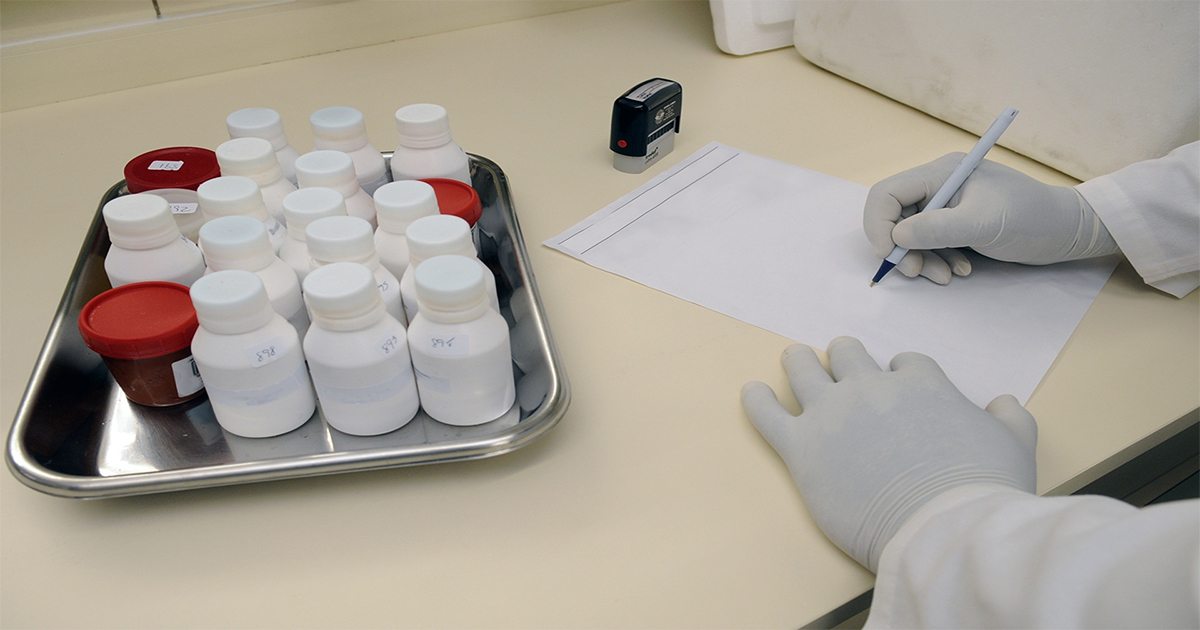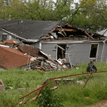Mesothelioma Help Cancer News

Probe May Guide Surgeons to Successful Removal of Mesothelioma Cells
MesotheliomaHelp has reported on numerous attempts by researchers to develop a tool that causes cancer cells to glow allowing surgeons to home in on them during surgery. Now, researchers believe they have developed a probe that will light up cancer cells and give surgeons confidence that they can remove all cancer cells.
Researchers from Michigan Tech focused on beta-galactosidase, a key enzyme with a “long track record in medical science,” according to the researchers. The probe the team developed bonds to the beta-galactosidase leading to a bright glow under fluorescent light.
“Doctors need to pinpoint cancer tissue, but that can be hard,” said Haiying Liu, lead researcher and a chemistry professor at Michigan Technological University. “If we could make beta-galactosidase glow brightly during surgery, it could play a major role in improving outcomes.”
The researchers believe their light-up approach is superior to others for the following reasons:
- The near-infrared glow can penetrate deeper into the tissue giving surgeons a view of tumors underneath healthy tissue.
- The glow is a bright white light and not blue or green like others that can be distracting.
- The fluorescence is “stable and long lasting” making it useful in long cancer surgeries.
Mesothelioma, an unusual form of cancer caused by exposure to airborne asbestos fibers, often has a complex growth pattern making complete surgical removal a very difficult task. Surgeons often have to guess how much tissue to remove, then send samples to the lab for confirmation that they got it all. They also do not want to remove too much healthy tissue. Use of the probe could eliminate guesswork.
“Doctors want to remove all the cancer, but they also don’t want to cut too much,” Liu said. “We want to make their job a little easier.”
Currently, there is no treatment available for mesothelioma that has shown a 100% efficacy rate. Mesothelioma cancer cells have proven to be resistant to the standard treatments of chemotherapy and radiation. While not all mesothelioma patients are candidates for surgery, those who are, may see a higher success rate with surgeons able to pinpoint all cancer cells.
Read the full study in the March 8 issue of the journal Analytic Chimica Acta.

Blood Test Tool For Early Detection of Mesothelioma
MesotheliomaHelp has reported multiple times on the ongoing research to use liquid biopsies or blood samples to detect and manage the treatment of cancer. The non-invasive approach is easier on patients and can return results more quickly. Now, researchers report they have developed a tool that can look at a blood sample and determine whether cancer is present and its point of origin.
Find out more about research using blood tests here and here.
Researchers from The University of California, Los Angeles are using their proprietary tool CancerLocator to detect circulating cell-free DNA and to look at the genome-wide DNA methylation profile to detect cancer, according to a March 24 article in GenomeWeb. The tool, in effect, cross checks the DNA methylation data against a database the team developed that contains information about methylation markers common across cancers and specific to certain tissues, in seven cancers, including lung tissue.
“We have developed a computer-driven test that can detect cancer, and also identify the type of cancer, from a single blood sample,” said lead researcher Jasmine Zhou, Department of Pathology and Laboratory Medicine, David Geffen School of Medicine, UCLA.
During the study, the team found that the CancerLocator outperformed both the random forest and support vector machine standard algorithms in simulated data as well as with live cancer data. The test was also effective for detecting early-stage cancers.
Research shows that metastasis is the cause of nearly 90 percent of cancer deaths. Stopping tumor growth and preventing metastasis is critical, especially for mesothelioma and lung cancer where the diseases are highly aggressive. This can only be achieved if the cancer is detected early.
Mesothelioma, a rare form of cancer caused by past exposure to asbestos, is highly aggressive and is resistant to many cancer treatments making it a difficult disease to treat effectively. The prognosis for mesothelioma patients is usually grim: the average survival time varies from 4 – 18 months after diagnosis. Early detection can mean prolonged survival.
Although there are various cancer screening tools available, such as the colonoscopy for colon cancer, many of the tests are invasive and painful for the patients. However, in this case, there is no reliable method for early detection of the deadly mesothelioma cancer.
Zhou notes that with CancerLocator “the higher the fraction of tumor DNAs in blood, the more accurate the program was at producing a diagnostic result. Therefore, tumors in well-circulated organs, such as the liver or lungs, are easier to diagnose early using this approach than in less-circulated organs such as the breast.”
“The technology is in its infancy and requires further validation, but the potential benefits to patients are huge,” said Zhou.
Each year nearly 3,000 Americans are diagnosed with mesothelioma. The key to increased life expectancy when battling this cancer is early detection.
Read the full study in the March 24 issue of Genome Biology.

Appreciate & Respect Your Father while He’s Still Here
Last night, my husband and I were on a date… to the grocery store. (We’re quite glamorous that way!) I was walking down an aisle when I noticed a man standing in the middle of it with his cart. His daughter, who must have been in her 20s was with him, helping him choose some brownies from the shelf. I heard her say, in an angry tone, “So you like these ones!” She then noticed me, as I was waiting to go around her father, and proceeded to yell, “Dad, you’re in the way!” I told him that it was no trouble, and mumbled under my breath as I passed the girl, “Don’t talk to him that way.” As they were leaving the aisle, I saw the gentleman looking as though he were a schoolboy who had been scolded by the teacher. As I heard her bellow, “Anything else?”, tears filled my eyes.
I managed to hold it together for the remainder of our shopping, but the second we got into our vehicle, the tears started to flow. My husband looked at me, confused. I told him what I witnessed. I am a pretty non-confrontational person, but never in my life had I wanted to say something so badly; I wish she had heard my mumbled disapproval. I started to think of what I would have said if she had responded.
I knew exactly what it would have been:
“Miss, you don’t know how good you have it. You don’t know what you’re doing. You see, I lost my Dad three years ago to an awful disease and I would give anything to have the chance to grocery shop with him. Sure, I know that things can get frustrating at times, but this man that you’re here with, he matters. You might feel like you’d rather be anywhere else, but from my perspective, there’s nowhere else I’d rather be right now. You’re wasting a precious opportunity to make memories with your father, and you can’t get these moments back.”
“Look at your Dad’s face. Can’t you see that you’re hurting him? Be patient with him. He probably looked at this outing as some great bonding time between a father and daughter, but instead, he is left with complete and utter disappointment.”
“I’ll pray for him tonight; I’ll pray that he finds comfort. And I’ll pray for you. My prayer for you, young woman who thinks you are too grown up for your Dad, is that you never have to know the kind of heartbreak and heartache that I do. I’ll pray that God helps you to remember how good you do have it, and to appreciate it every day.”

Why Is Mesothelioma Increasing?
There has been a significant increase in death rates from mesothelioma in the past decade. The increase in mesothelioma cases has been attributed to the lack of a complete ban on asbestos in the U.S., significant natural disasters that destroyed buildings containing asbestos materials, and the Sept. 11 terror attacks that exposed rescue workers to the cancer-causing material, among other factors.
How Many Cases of Mesothelioma Are Diagnosed Each Year?
 Because the life expectancy for mesothelioma patients is generally one to two years, the number of cases diagnosed each year can be measured relative to the death rate. From 2005 to 2015, researchers saw a 7.8 percent increase in death rates from mesothelioma, according to the latest Global Burden of Disease Study (GBD 2015) published Oct. 8, 2016, in The Lancet. The study notes that the number of deaths worldwide from mesothelioma in 2015 was 33,400.
Because the life expectancy for mesothelioma patients is generally one to two years, the number of cases diagnosed each year can be measured relative to the death rate. From 2005 to 2015, researchers saw a 7.8 percent increase in death rates from mesothelioma, according to the latest Global Burden of Disease Study (GBD 2015) published Oct. 8, 2016, in The Lancet. The study notes that the number of deaths worldwide from mesothelioma in 2015 was 33,400.

In another study focusing on the U.S. alone, an estimated 15,000 Americans die every year from asbestos-related diseases, with mesothelioma accounting for nearly 3,000 deaths per year. The Environmental Working Group (EWG) indicates that during the period from 1999 to 2013, an estimated 127,579 to 159,480 Americans died from asbestos exposure.
What Is Causing the Rise in Mesothelioma in the U.S.?
There are several factors that may be contributing to the increase in mesothelioma cases in the United States:
 Asbestos use has not been banned completely in the U.S., and asbestos-containing materials remain in place in older homes, businesses, and schools. “Approximately 1.3 million workers in construction and general industry potentially are being exposed to asbestos during maintenance activities or remediation of buildings containing asbestos,” according to a report from the Centers for Disease Control and Prevention and the National Institute for Occupational Safety and Health. Construction photo
Asbestos use has not been banned completely in the U.S., and asbestos-containing materials remain in place in older homes, businesses, and schools. “Approximately 1.3 million workers in construction and general industry potentially are being exposed to asbestos during maintenance activities or remediation of buildings containing asbestos,” according to a report from the Centers for Disease Control and Prevention and the National Institute for Occupational Safety and Health. Construction photo Devastating storms, including Hurricane Katrina in 2005 and Hurricane Sandy in 2012, led to the destruction of buildings with asbestos-containing materials, increasing the risk of asbestos exposure. Future storms will have the same effect. Hurricane damage photo
Devastating storms, including Hurricane Katrina in 2005 and Hurricane Sandy in 2012, led to the destruction of buildings with asbestos-containing materials, increasing the risk of asbestos exposure. Future storms will have the same effect. Hurricane damage photo The 9/11 terrorist attacks exposed an estimated 41,000 people to asbestos and other toxins during the rescue and clean-up efforts after the Twin Towers collapsed, according to the CDC. 9/11 rescue worker photo
The 9/11 terrorist attacks exposed an estimated 41,000 people to asbestos and other toxins during the rescue and clean-up efforts after the Twin Towers collapsed, according to the CDC. 9/11 rescue worker photo Mineral mines in some states such as Montana and Minnesota may have contributed to higher than expected rates of mesothelioma. Miner photo
Mineral mines in some states such as Montana and Minnesota may have contributed to higher than expected rates of mesothelioma. Miner photo
Mesothelioma can develop 15 to 60 years after asbestos exposure occurs. That means any time there is an issue, such as a hurricane, for example, the potential for the rising number of mesothelioma cases extends for many more decades. Preventing asbestos exposure is the only sure way to halt increased rates of mesothelioma.
Which States Have the Most Mesothelioma Cases?
The number of mesothelioma cases is higher in the most populous states. California, Florida, Pennsylvania, New York, and Texas had the most asbestos-related deaths over the 14-year period covered in the EWG study. However, Delaware, Maine, Montana, Pennsylvania, Washington, and West Virginia had death rates that were 50 percent to 100 percent higher than the national average of 4.9 per 100,000 people.
I think we should separate into two charts here for comparison:
| State | NUMBER OF MESOTHELIOMA DEATHS (1999-2013) |
| California | 3,997 |
| Florida | 2,619 |
| Pennsylvania | 2,601 |
| New York | 2,253 |
| Texas | 2,064 |
| State | ASBESTOS-RELATED DEATH RATES (1999-2013)* |
| Maine | 10.1 |
| West Virginia | 9 |
| Montana | 7.9 |
| Delaware | 7.6 |
| Pennsylvania | 7.5 |
| Washington | 7.5 |
*Deaths per 100,000 people
What Does the Future Hold for Mesothelioma Cases in the U.S.?
“Ensuring a future decrease in mesothelioma mortality requires meticulous control of exposures to asbestos and other materials that might cause mesothelioma.”
Centers for Disease Control and Prevention, “Malignant Mesothelioma Mortality – United States, 1999-2005“

Nurse Wishes Mary Hesdorffer Well As She Retires
The ability to command the respect and admiration of people from all walks of life is not something that is easily accomplished. For the mesothelioma community, Nurse Practitioner, Mary Hesdorffer R.N., of the Mesothelioma Applied Research Foundation, is one person who has been central to the mission of raising awareness for this rare cancer, published research, comforted thousands of patients and family members, and earned the respect of mesothelioma research scientists and clinicians.
As the Executive Director of the Mesothelioma Applied Research Foundation, Mary has dedicated herself to raising funds, and is a huge advocate, for the mesothelioma community to fund research. It would be impossible to list all of the accomplishments that Mary has achieved over the years. What sums it up is a tribute from a patient’s family member on the Meso Foundation’s web site, “Mary took the confusion out of the diagnosis.”
The Mesothelioma Applied Research Foundation has an annual conference that includes scientists, researchers, patients and families. The foundation, the only non- profit for mesothelioma is dedicated to research to finding a cure for mesothelioma. This year the conference will be held March 27 – 29 at the National Institutes of Health in Bethesda, Maryland.
In addition to hearing the latest updates on mesothelioma research, the conference will be a time to wish Mary Hesdorffer well. Mary has been with the Meso Foundation since the beginning. In her various roles over the years, she has been the one that the mesothelioma patients and families know. With countless hours, phone calls, and time dedicated to the mesothelioma community, Mary has been the go-to person for information, support and advocacy. Whether speaking at conferences, conducting support groups or reaching out to patients, Mary has been a constant, familiar face for mesothelioma families and the medical community. Everyone in the mesothelioma community knows Mary.
We wish Mary well in the next phase of her life. She will never be replaced or forgotten for all she has done, and will most certainly continue to do, for the mesothelioma community. Well done!
Free Mesothelioma Patient & Treatment Guide
We’d like to offer you our in-depth guide, “A Patient’s Guide to Mesothelioma,” absolutely free of charge.
It contains a wealth of information and resources to help you better understand the condition, choose (and afford) appropriate treatment, and exercise your legal right to compensation.
Download Now Asbestos use has not been banned completely in the U.S., and asbestos-containing materials remain in place in older homes, businesses, and schools. “Approximately 1.3 million workers in construction and general industry potentially are being
Asbestos use has not been banned completely in the U.S., and asbestos-containing materials remain in place in older homes, businesses, and schools. “Approximately 1.3 million workers in construction and general industry potentially are being  Devastating storms, including Hurricane Katrina in 2005 and Hurricane Sandy in 2012, led to the destruction of buildings with asbestos-containing materials, increasing the risk of asbestos exposure. Future storms will have the same effect. Hurricane damage photo
Devastating storms, including Hurricane Katrina in 2005 and Hurricane Sandy in 2012, led to the destruction of buildings with asbestos-containing materials, increasing the risk of asbestos exposure. Future storms will have the same effect. Hurricane damage photo The 9/11 terrorist attacks exposed an estimated 41,000 people to asbestos and other toxins during the rescue and clean-up efforts after the Twin Towers collapsed, according to the CDC. 9/11 rescue worker photo
The 9/11 terrorist attacks exposed an estimated 41,000 people to asbestos and other toxins during the rescue and clean-up efforts after the Twin Towers collapsed, according to the CDC. 9/11 rescue worker photo Mineral mines in some states such as Montana and Minnesota may have contributed to higher than expected rates of mesothelioma. Miner photo
Mineral mines in some states such as Montana and Minnesota may have contributed to higher than expected rates of mesothelioma. Miner photo